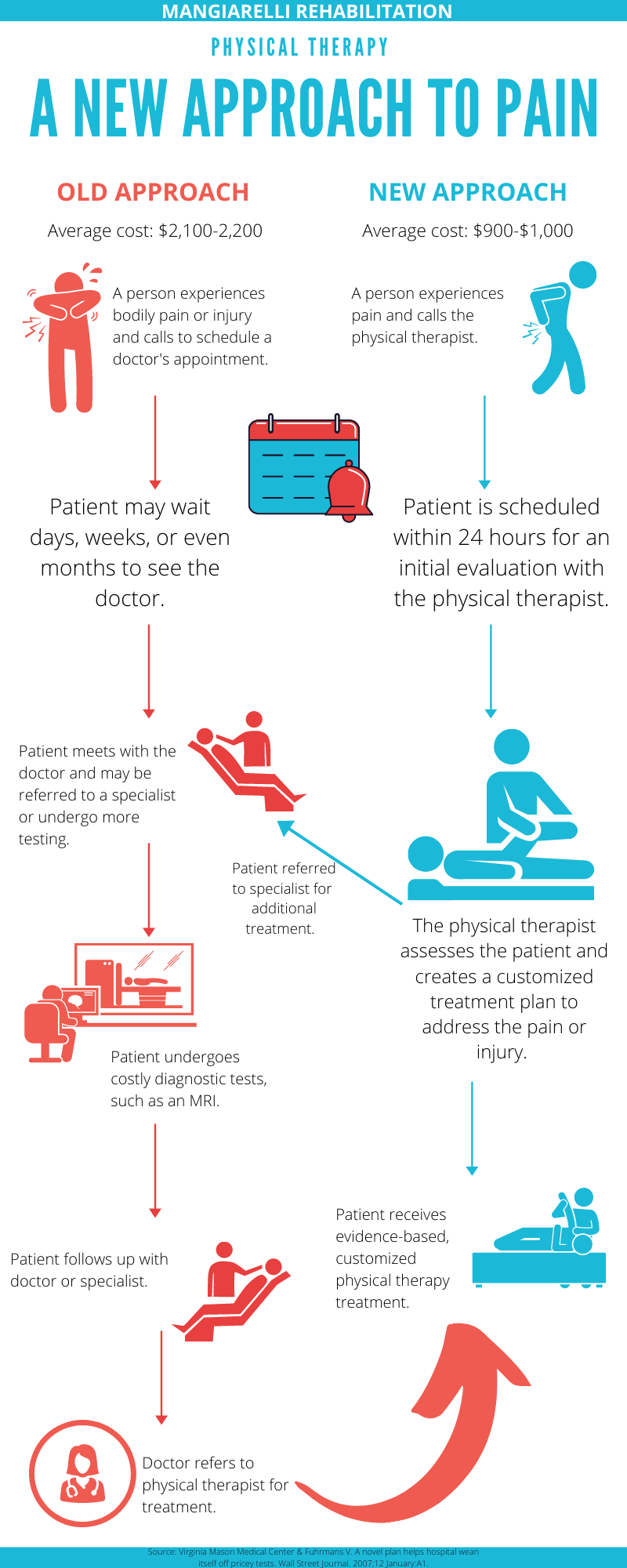Physical Therapy: A New Approach to Pain
Over the last twenty years, studies have shown that direct access to your physical therapist for outpatient care of musculoskeletal pain and injury leads to fewer visits and lower overall medical costs. This has led nearly all U.S. states to allow patients direct access to physical therapists, meaning that patients do not need a referring script from a physician to go to physical therapy in most cases. [In the following cases, scripts are required: workers compensation and those with Medicare coverage.]
Traditional Approach to Pain
When a person experiences bodily pain or injury, they often call to schedule a doctor’s appointment. They may end up waiting days or weeks to see the doctor. Once they meet with their primary care physician, they may be referred to an orthopedic specialist or be sent for costly diagnostic tests. The orthopedic specialist may then refer the patient to physical therapy.
This process can set a person back financially with several insurance co-pays, costly diagnostic testing, delayed treatment, and potentially, use of surgery or opioids to manage pain. For example, the average cost of an MRI is $2,611, while the average cost of a two-night hospital stay is $3,852. The average cost of a year supply of opioids is $6,754.
New Approach to Pain: Physical Therapy
Seeing a physical therapist first can reduce the total cost of medical care by 50%. Physical therapy is a cost-effective treatment covered by most insurances to get patients back to daily life more quickly with lasting results. In the approach of directly accessing physical therapy, a person calls their physical therapist with the onset of musculoskeletal pain. At Mangiarelli Rehabilitation, the patient is scheduled within 24 hours for an initial evaluation with a physical therapist. The physical therapist assesses the patient and creates a customized treatment plan to address the pain. The patient receives evidence-based, customized physical therapy treatment. If needed, the physical therapist will refer to a specialist for additional treatment. Average cost for a full episode of physical therapy care is $1,000, much of which is covered by insurance.
Physical therapy has proven to lower medical costs by reducing the need for multiple referrals, unnecessary medication, imaging scans, and surgeries. A study by the Virginia Mason Medical Center investigated health care spending and revealed that early physical therapy intervention for back pain led to decreased use of imaging, lower health care spending, less work lost due to pain, and improved productivity. Those who received physical therapy first had average savings of 19% compared to those who had injections and savings of 75% for those who had surgery. The study showed that when they referred to physical therapists first, appointment wait times fell to one day, MRI use dropped by one-third within the year, and only six percent of patients lost time from work. Treatment costs fell by half.
Another study on neck and back pain showed that individuals directly accessing physical therapy significantly lowered medical costs and use of healthcare services in comparison to those who chose the traditional medical referral to address their pain. Both groups showed improvements in pain and disability, while the physical therapy first patients had lower medical costs.
Directly accessing a physical therapist for your musculoskeletal care makes healthcare more affordable and accessible. Research has shown that direct access to physical therapy does not diminish collaboration between physicians and physical therapists and the continuity of care between patients and their physicians is not interrupted by the patient’s use of physical therapy first for musculoskeletal issues. Direct access to physical therapy serves the patient and the healthcare system by reducing medical costs and most importantly, providing the patient with effective, affordable treatment to regain function and health.
